Caracol – Visiting Belize’s Amazing Sky Palace
This is my second post from Belize, the final country on Victor Romagnoli’s one of a kind guided odyssey through all of Central America for Canadian tour company Adventures Abroad. In the first post from Belize I gave my first impressions of this tiny country as we visited several Mayan sites including climbing El Castillo at Xunantunich. In this post we’ll pay our final visit to a Mayan archaeological site, the very important city of Caracol where there is a chance to climb the highest structure in the entire country, the aptly named Sky Palace. It’s a journey that will take an entire day on very bad roads through the Belizean rain forest. Please join us to find out if the effort to get to Caracol is worthwhile or something to take a pass on and enjoy the day relaxing at the wonderful Black Rock Lodge, as many in the group chose to do.
Black Rock Lodge
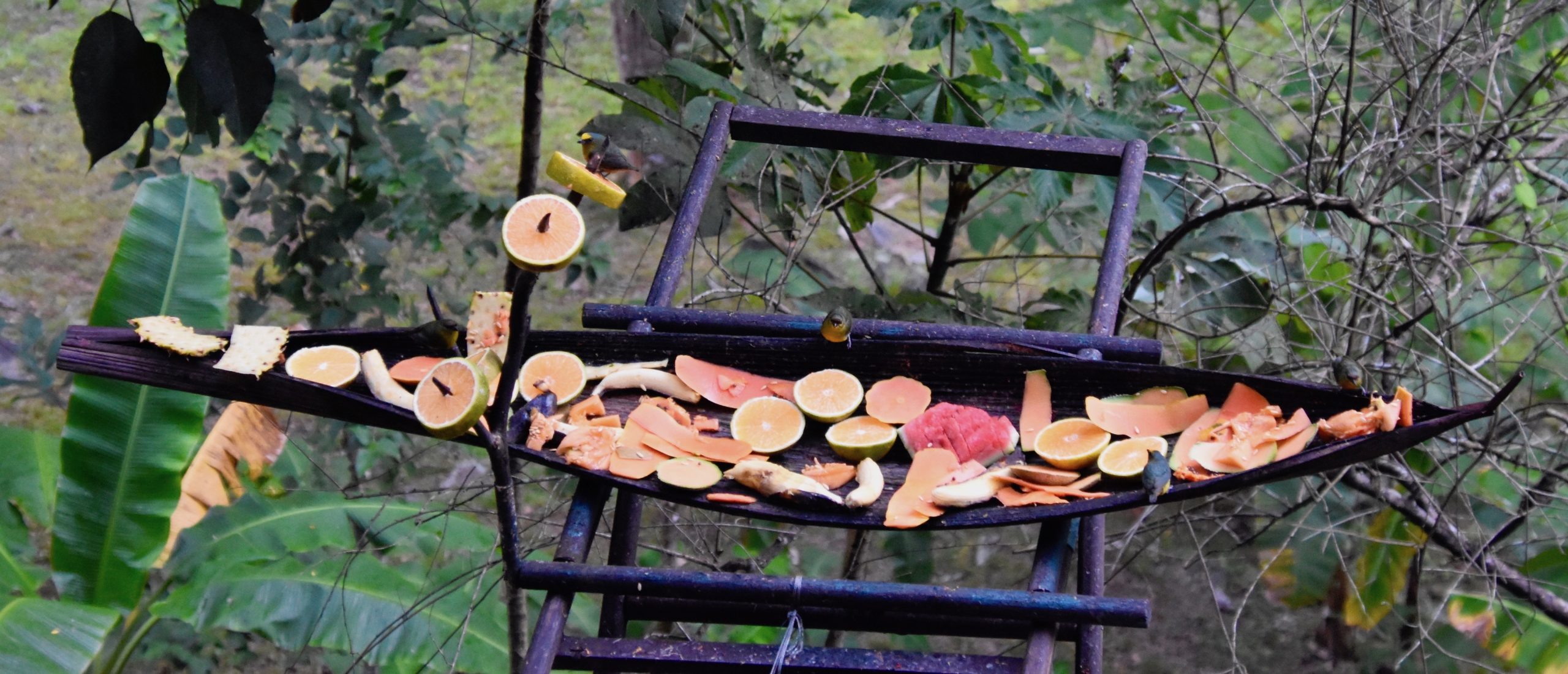
I’ve commented again and again in this series about both the quality and the variety of the accommodations Victor has selected for this trip and for our first two nights in Belize he has outdone himself with the Black Rock Lodge. It is an eco lodge located deep in the valley of the Macal River that lived up to every expectation I think one could have of a rain forest experience. Not only are the individual cabins and the main lodge excellent, but the surroundings are almost surreal. The lodge overhangs the river below and just over the railing is this feeder which is filled with a dozen types of fruits and nuts that attract an incredible variety of birds. Although it is hard to make out there are five different species in the photo above and over the course of our stay I saw at least thirty species, many of which were first timers for me. So first and foremost Black Rock Lodge is a birder’s delight, but there is far more than just birding.
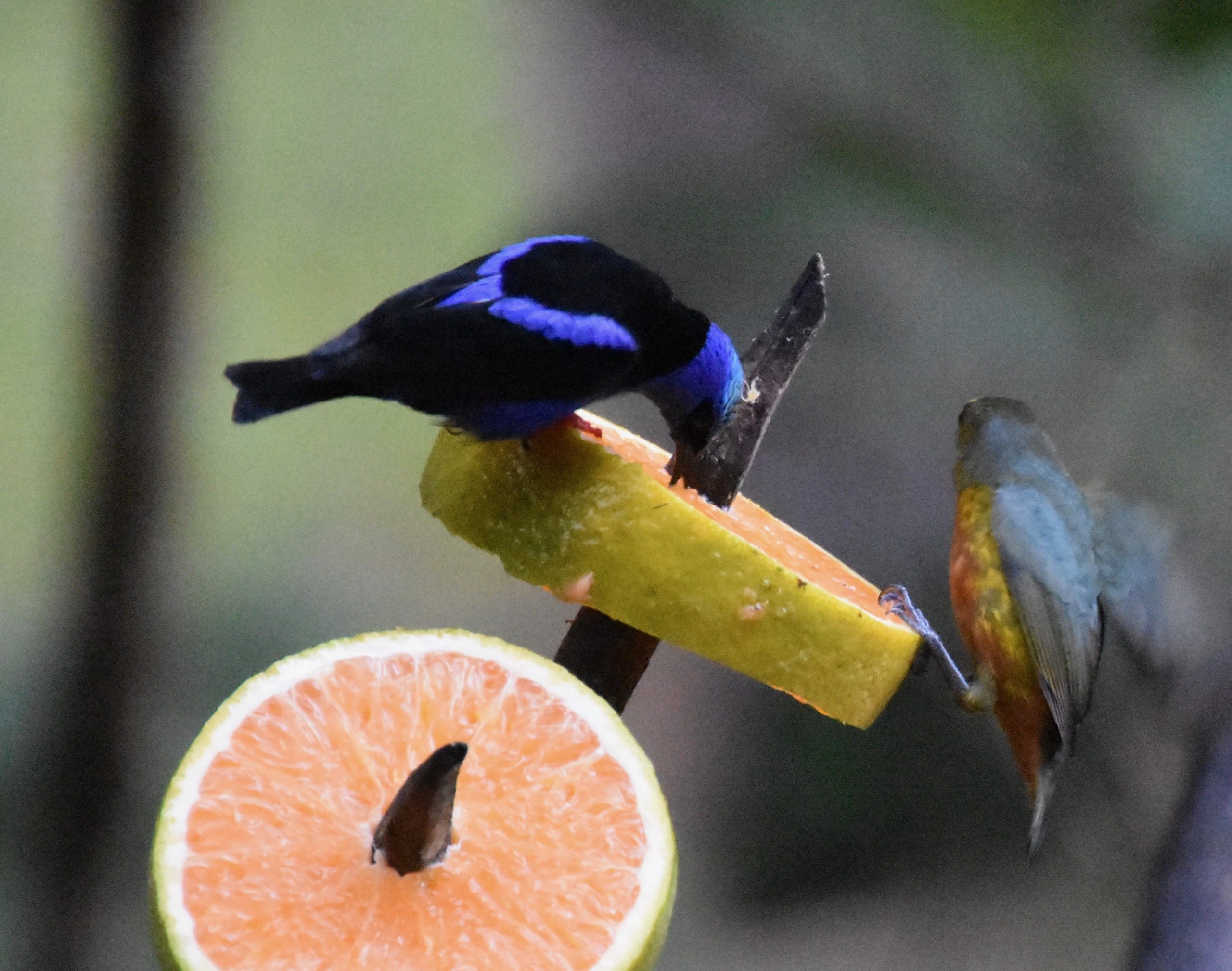
The lodge offers rain forest hiking to look offs high above the Macal River as well as to secluded caves and waterfalls, all the while looking for exotic birds, mammals, reptiles, amphibians, insects and flowers. If you are ever going to see one of Belize’s wild cats, whether it be an ocelot, margay, jaguarundi, puma or even jaguar, then these trails are the place. The staff at Black Rock Lodge all are expert naturalists and love what they do, introducing people like us to their wild kingdom.
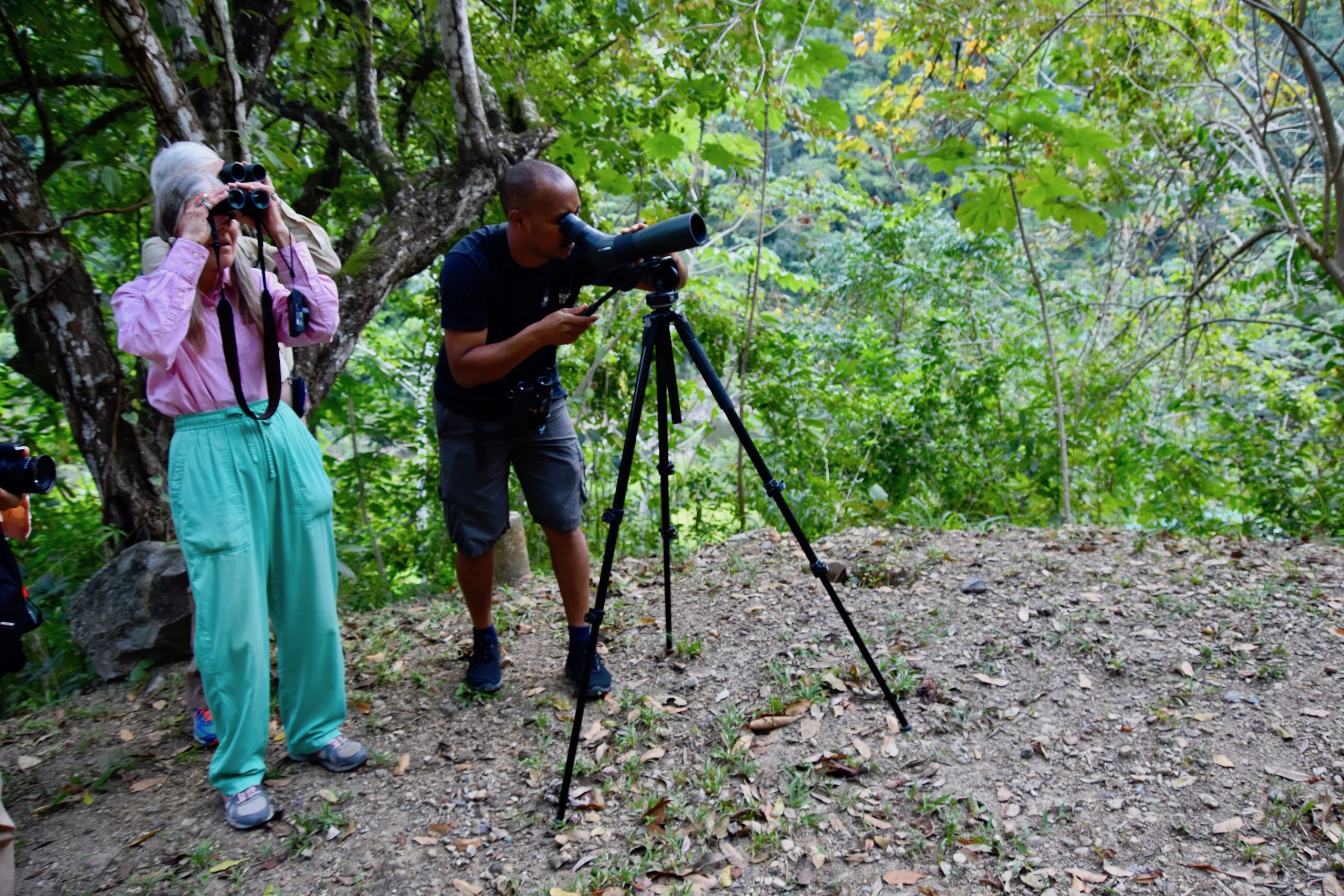
In addition to the natural side of things, Black Rock Lodge offers guided tours to nearby Mayan ruins of which Caracol is the most difficult to get to.
On top of all this the place is run on an entirely sustainable ecological model including generating its own electricity, wastewater treatment and recycling, use of natural products and growing their own produce. They even offer a tour to demonstrate how the place operates, doing the least damage possible to the rain forest that is under siege in so many places around the world.
I have to admit that before coming to Belize I associated it with its Caribbean coast and the barrier reef, but having visited Black Rock Lodge I would never return without spending at least a week in the rain forest.
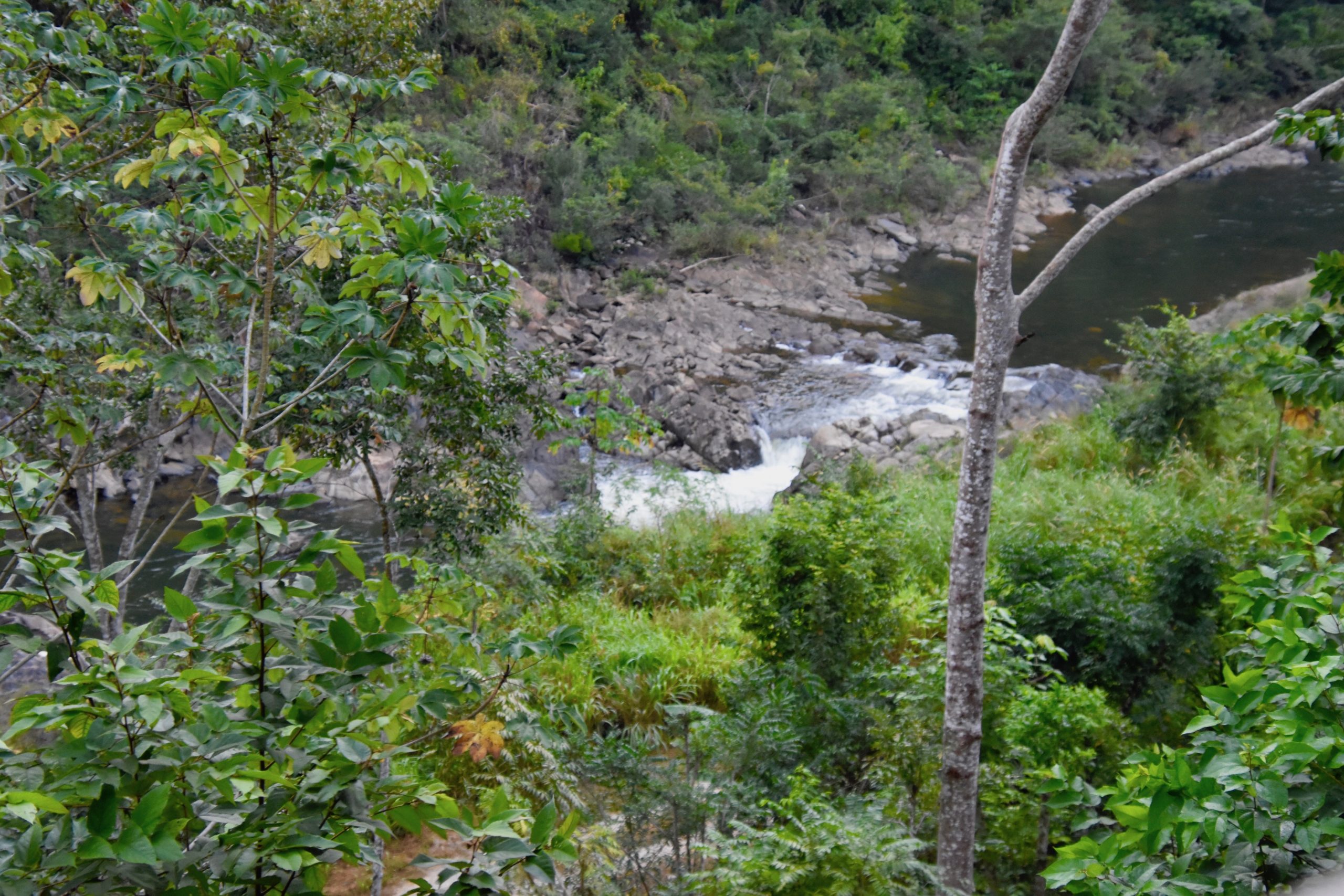
Getting to Caracol
The distance to Caracol from Black Rock Lodge was technically not that far, about 60-70 miles (100-110 kms.) I would guess, but we were told that it would take up to three hours due to the poor condition of the roads. So there would be six hours in a vehicle on shitty roads in the heat of the jungle with two hours at least in Caracol and a couple of other stops on the way there and back. Oh, and we were also told that due to hostilities between Guatemala and Belize there would be armed soldiers escorting visitors to the site. For this reason about half the group, including Alison, opted to enjoy the day birding and hiking around the lodge. For myself, there was never a chance I was going to pass this trip up.
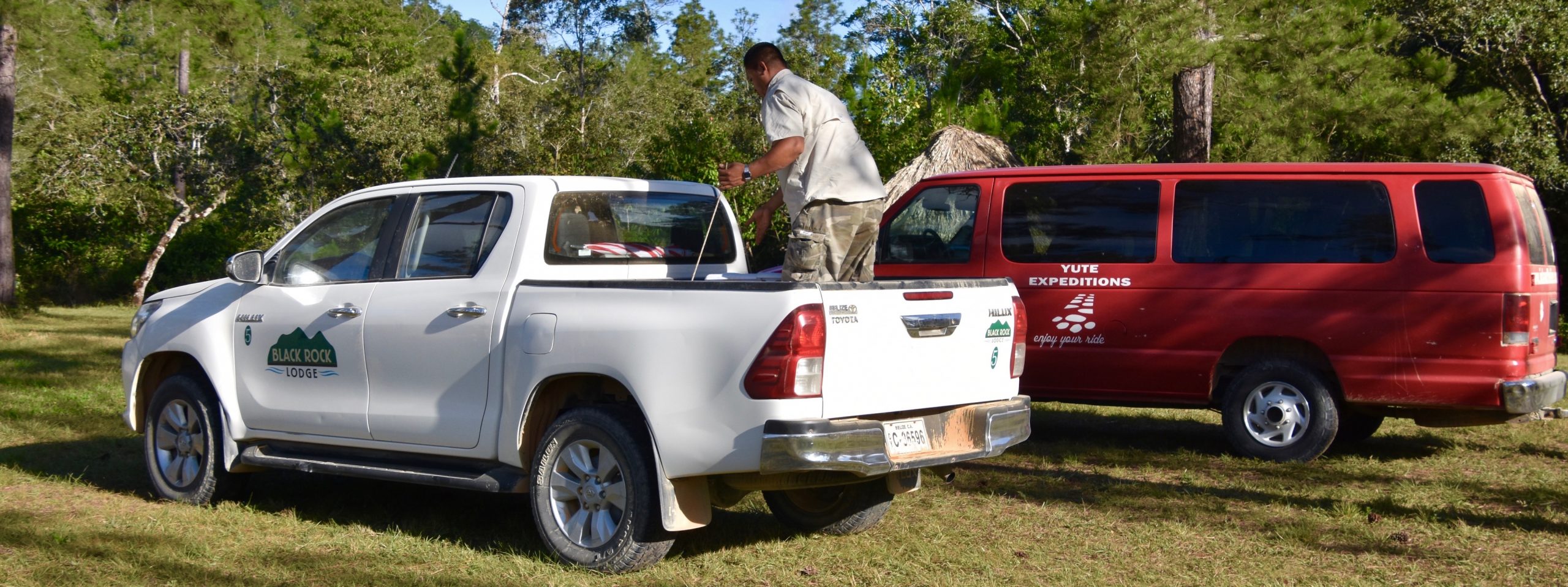
These were our two vehicles which the guides loaded with water and food and extra gas. Lynn and Brian Palardy and I hopped into the pickup truck and Victor and the rest into the van and we were off. The road into the lodge is quite rutty and bumpy and after less than a mile Victor knew his back could not withstand six hours of this so he had to bail and walk back to the lodge. I too suffer from severe lower back pain on occasion, so I know what he must have felt like and was glad he didn’t push himself for the sake of the rest of us. We had two good guides from the lodge as it was.
The description of the road to Caracol was not an exaggeration – it was terrible indeed. In places we couldn’t get above ten miles an hour, while in others we were jostled up and down so much that without seatbelts we would have been hitting our heads on the roof. The countryside was interesting with a few tiny villages at first, then a small farm or two and finally, a bit to my surprise, a pine forest.
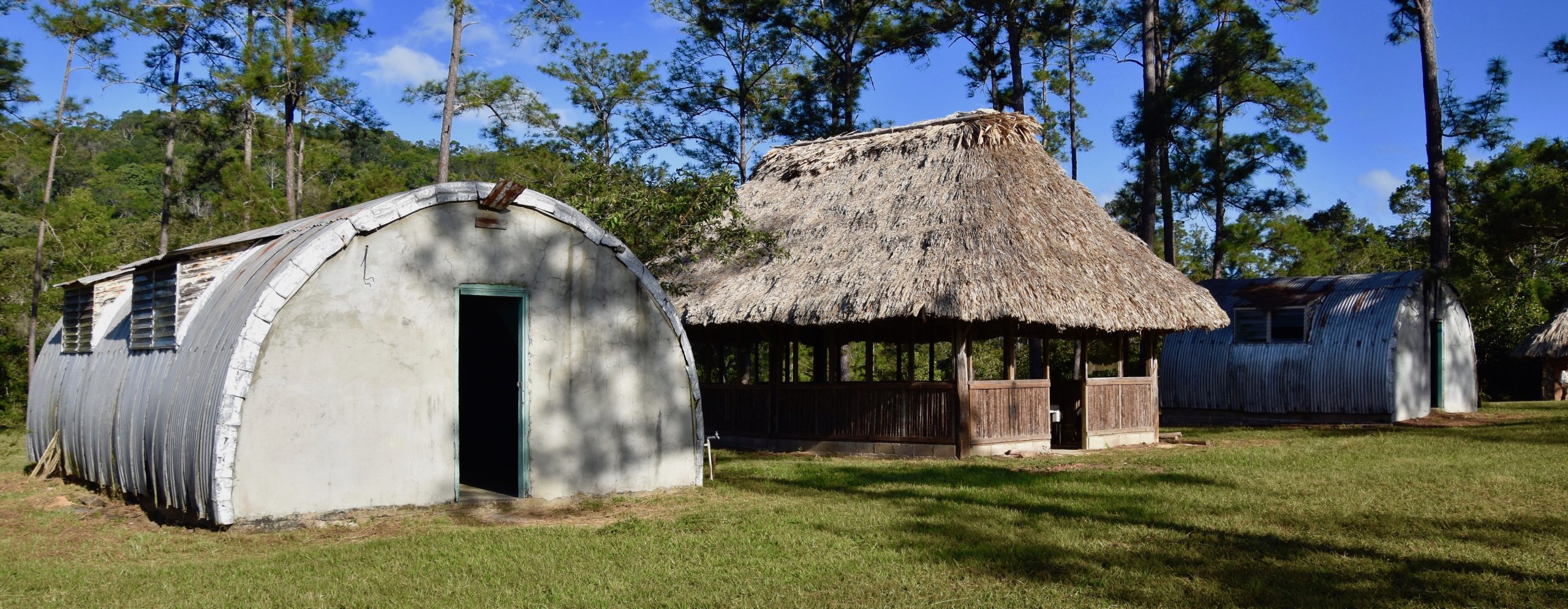
We made our first stop at an old English army camp which had been used up until independence as a place for training commandoes in jungle warfare. It was an interesting relic of the colonial past.
The next stop wasn’t planned, but foisted upon us by this boa constrictor that literally covered most of the road. He/she took its time slithering away into the undergrowth. I am not afraid of snakes and got out to take this photo, but everyone else remained firmly seated.
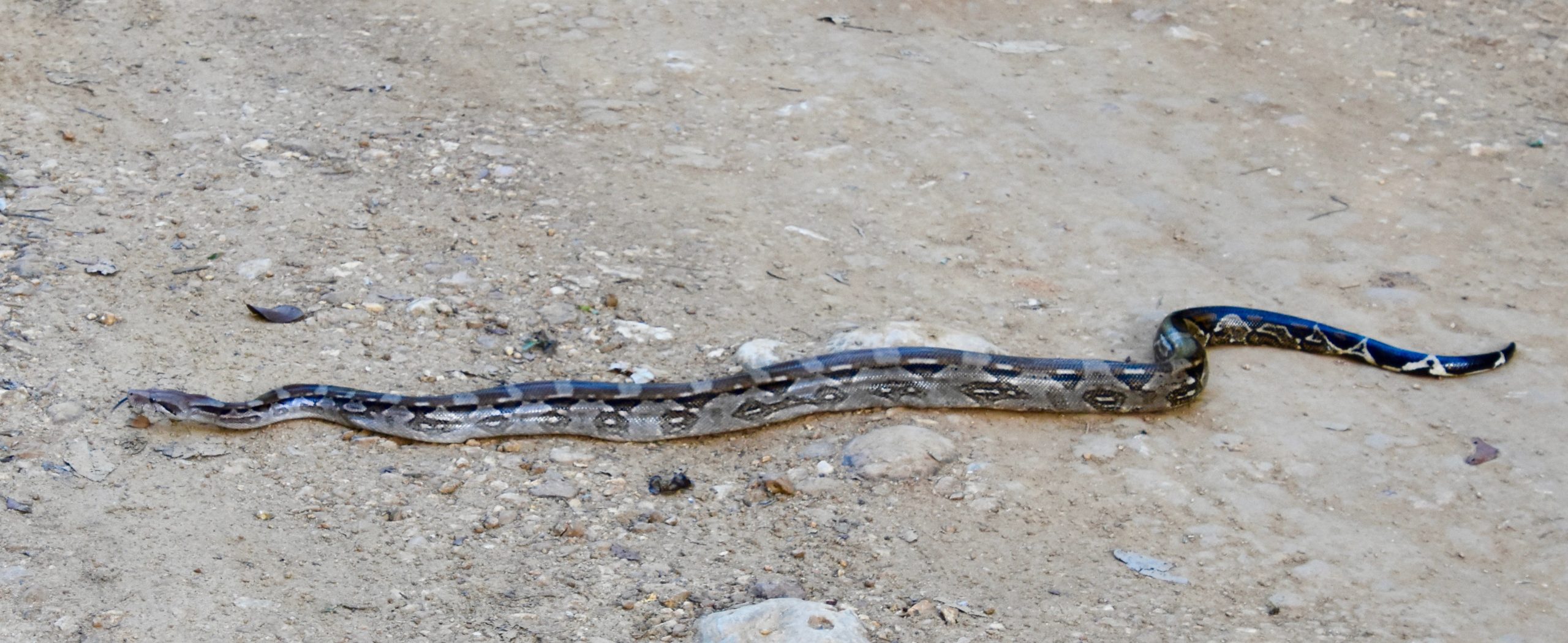
Stop number three was at Rio Frio Cave, which is technically not a cave, but a tunnel cut through the soft limestone by the Rio Frio, although at the entrance it sure looks like a cave.
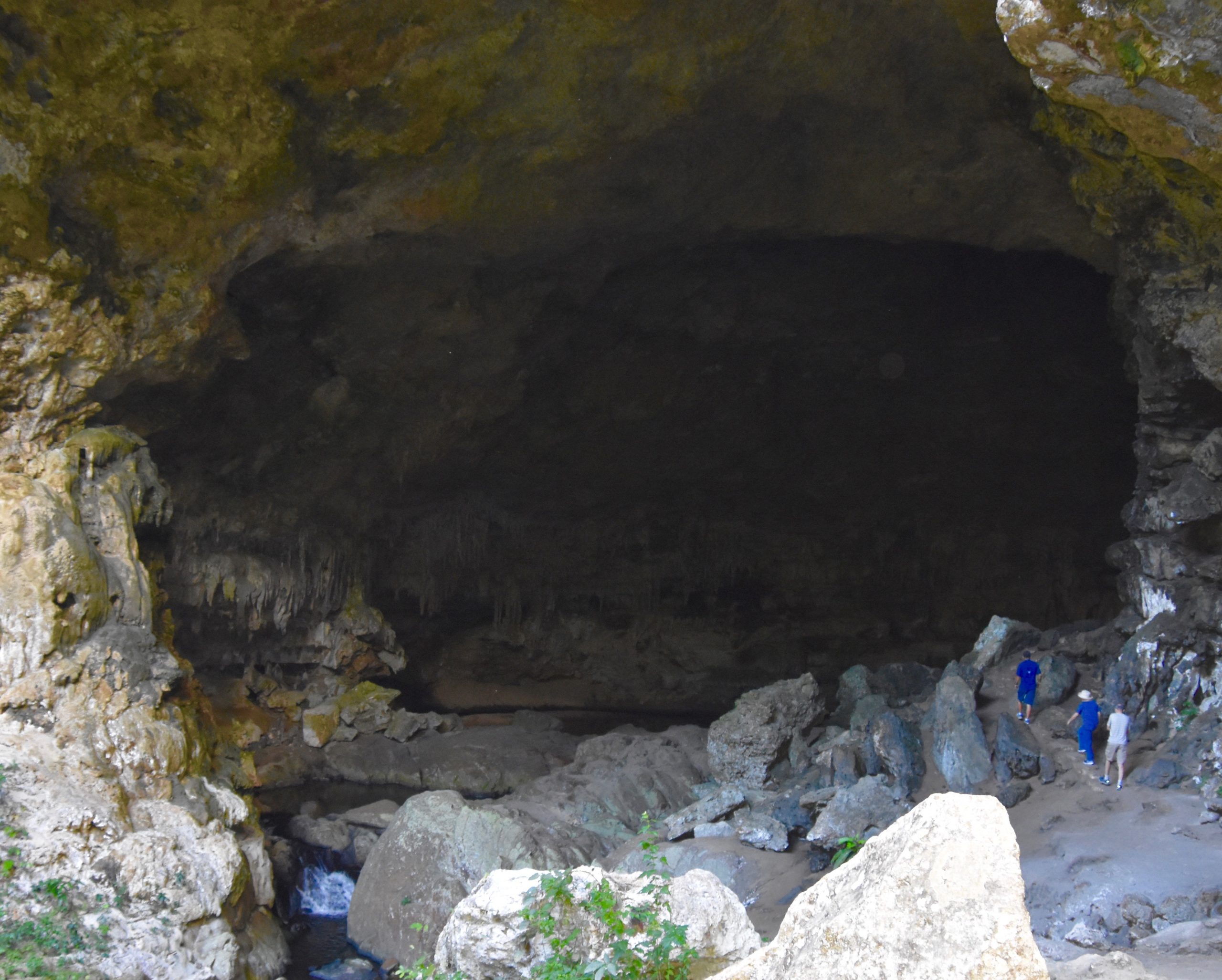
Only when you are inside can you see that it is a tunnel of about 300 yards in length.
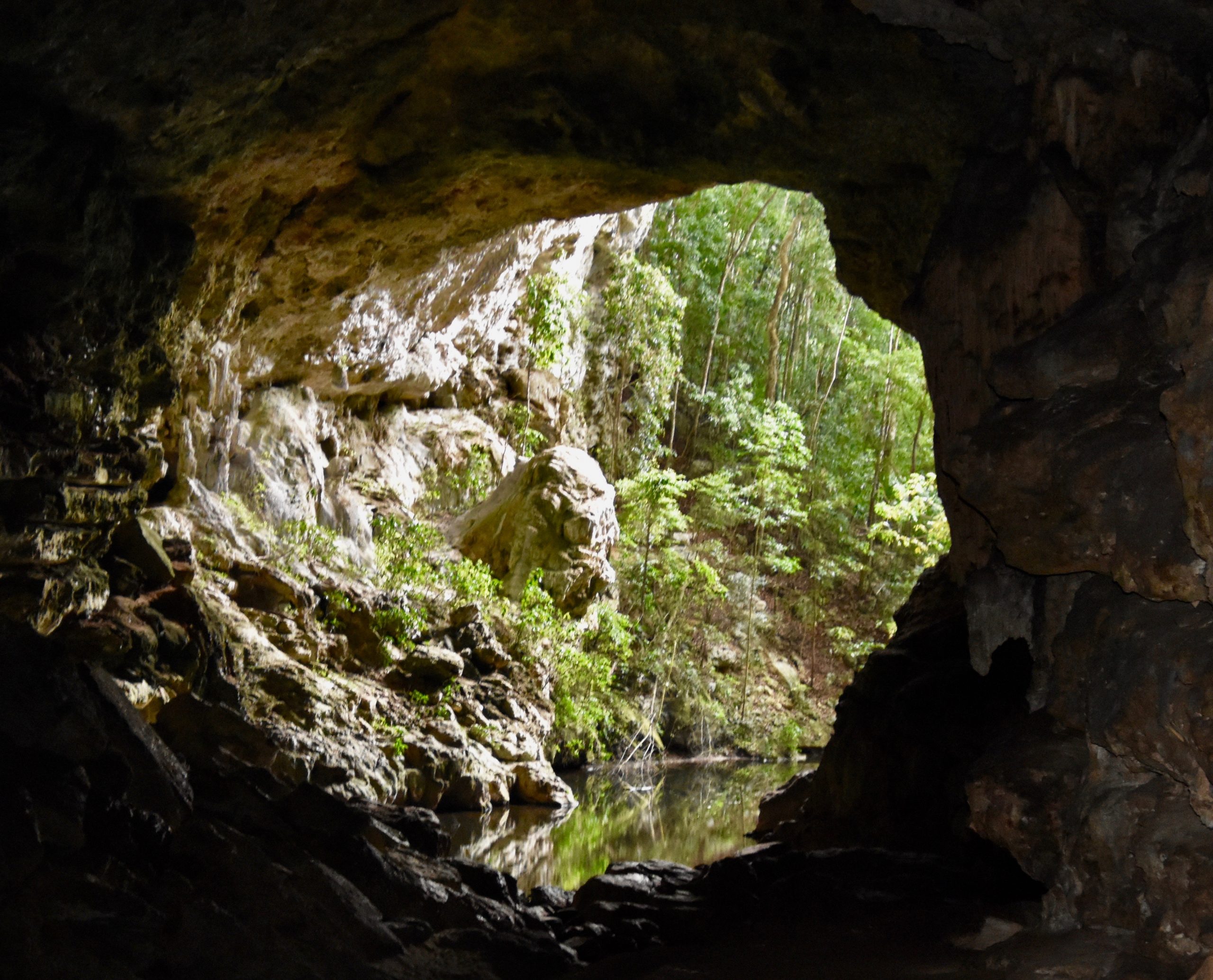
Back in the vehicles we continued on, leaving the pine forest and descending to a narrow crossing of the Macal River, the same one that runs past Black Rock Lodge.
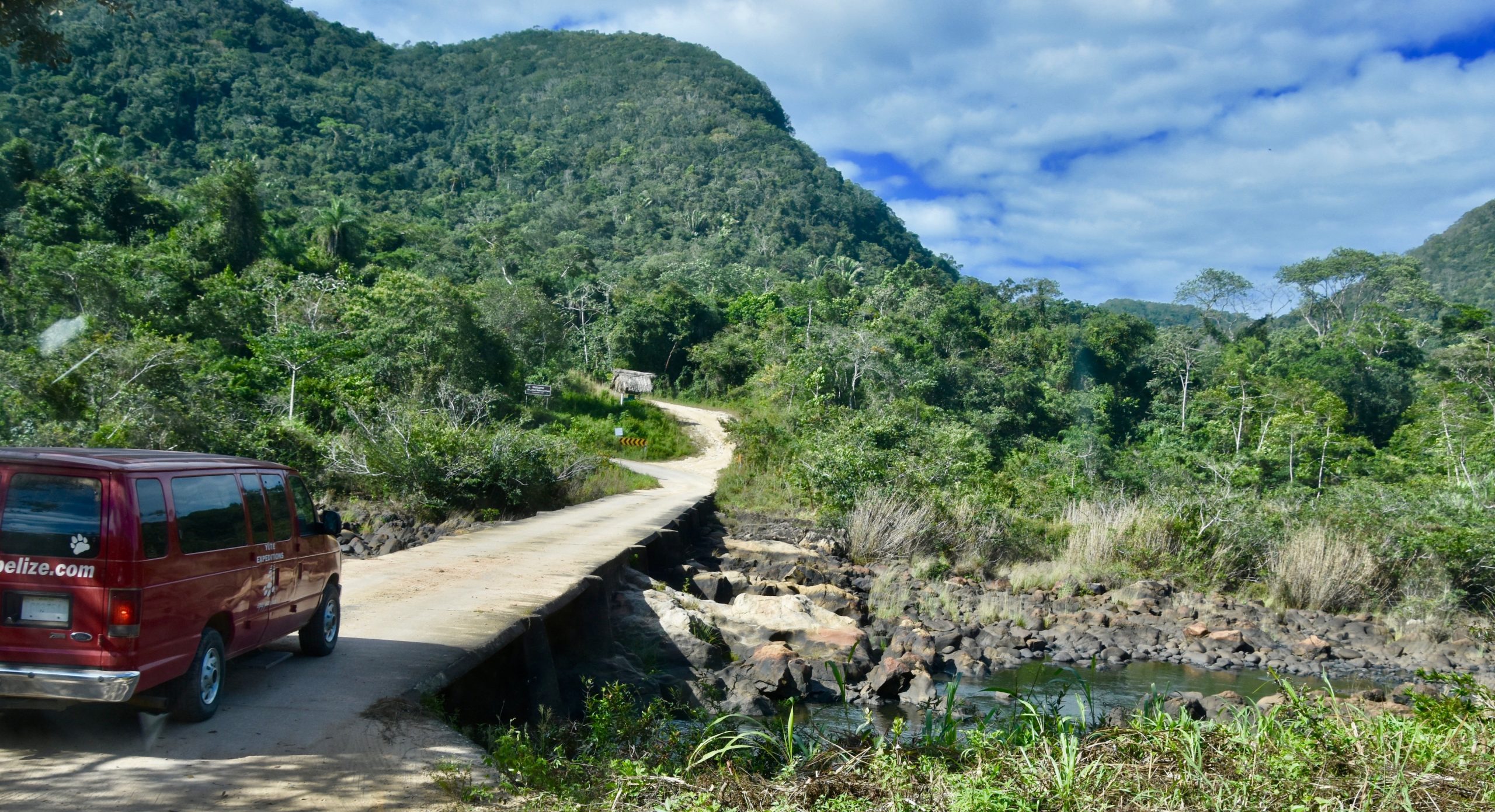
After three hours we finally arrived at the entrance to Caracol, but in truth with the stops along the way, it wasn’t that bad.
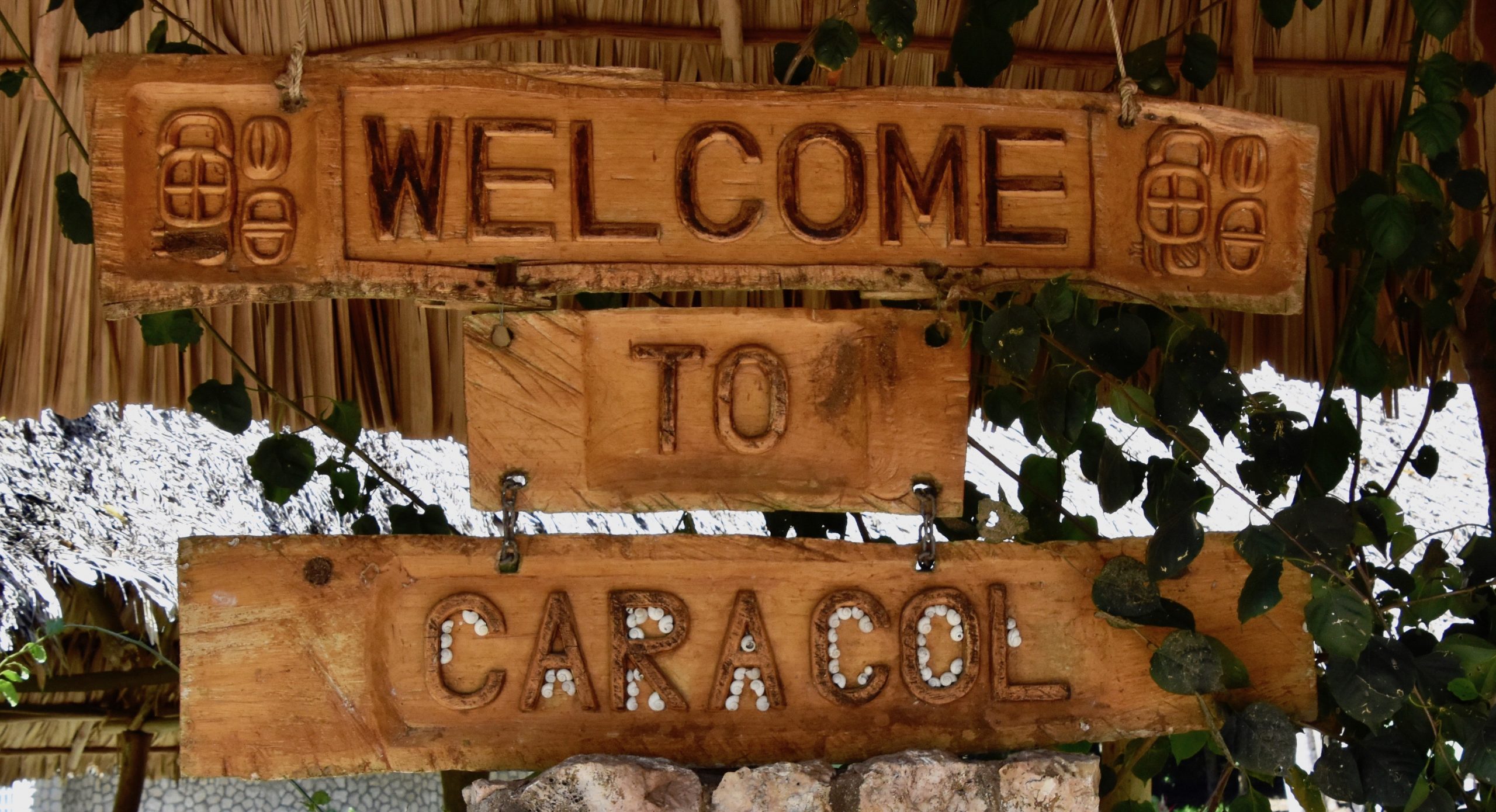
Notice those shells inside the Caracol lettering. Caracol means ‘snail’ and was the name given by modern visityors who noticed the abundance of land snails in the area. No one knows for sure what the real name actually was.
History of Caracol
The archaeological history of Caracol dates only from 1937 when it was rediscovered by a mahogany seeking lumberman. This is a truly amazing fact because we now know that at its height Caracol covered over twice the land area as modern day Belize City and had at least double the population, some think as many as 180,000. The Sky Palace is still the tallest structure in the entire country. Think of it – a city of this size and population just disappearing from sight for a thousand years. Perhaps for this reason, archaeologists at first did not think it was an important site, but the more they dug the more they found and Caracol is now reckoned to be one of the most important Mayan cities anywhere. The fact that it is so difficult to get to and that there is nothing on site in the way of restaurants, gift shops or anything usually associated with major archaeological places means it gets very few visitors and very little renown.
Settlement at Caracol dates as far back as 1,200 B.C., but as with many Mayan cities a timeline that is documented in stelae and altars sets an ‘official’ founding date of 331 by Te’ K’ab Chaak and runs through a series of rulers to 859 when the last king is mentioned, although not by name.
Deciphering of the dozens of altars and stelae has revealed that Caracol was frequently at war and usually victorious with a record of seven wins and two losses. The first war was lost to Tikal which we visited only two days before and which lies only about 60 miles (96 kms.) away as the crow flies. Caracol avenged that loss in the next war which led to a serious decline in Tikal’s fortunes for over a century. After that followed five wars with the city state of Naranjo which is even closer than Tikal. Caracol won the first four and lost the last. Kudos to Naranjo for never giving up. This was followed by a beat down of its closest neighbour Ucunal on the Mopan River in Guatemala and finally a last victorious war with Tikal, before fading away to nothingness. All those wars and so little to show for it. People never learn.
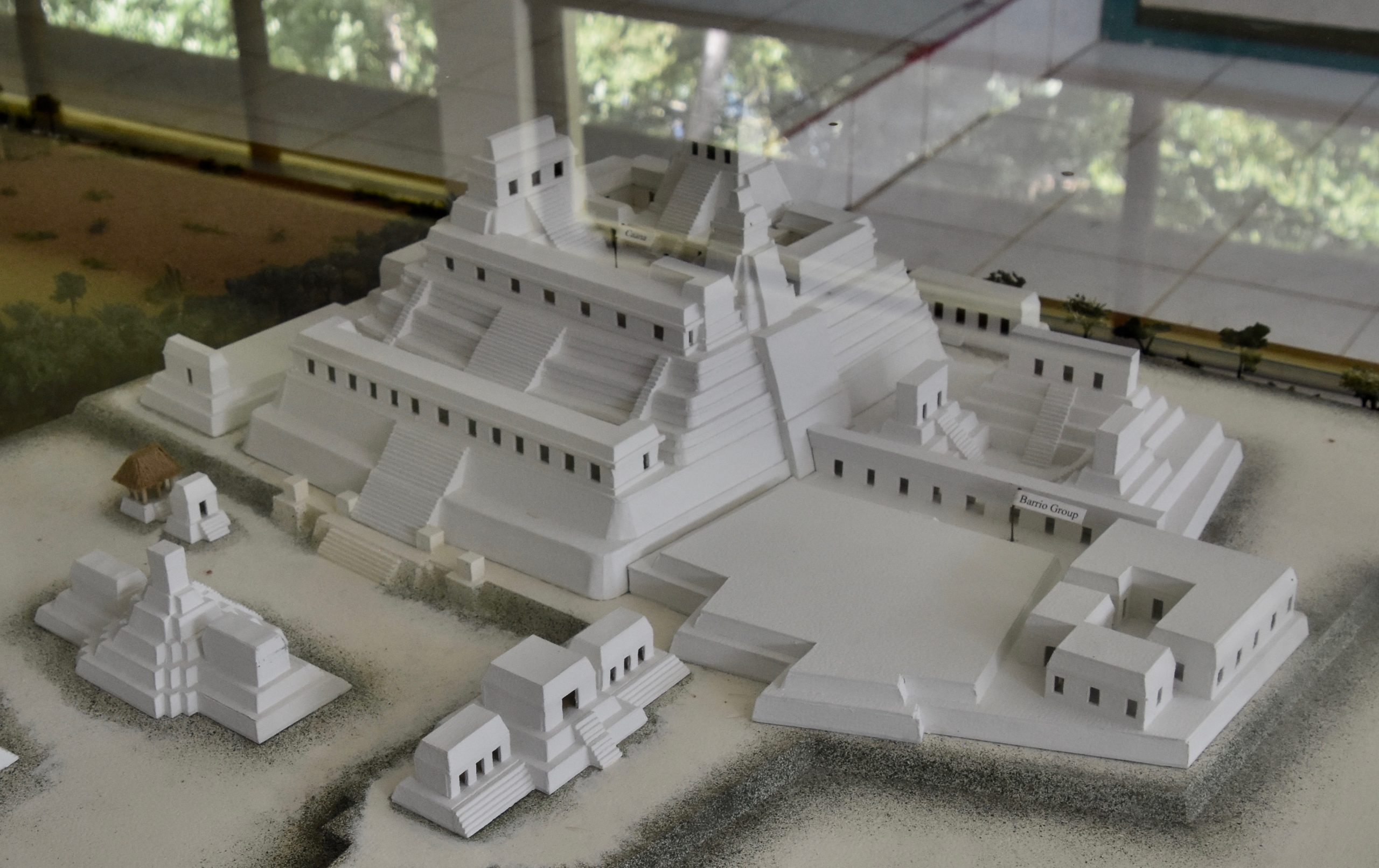
While there is no real museum on site, but there is a small building with a model of the Sky Palace and not much more. Aside from no activity on site there is also no admission fee that I am aware of, but at one point before arriving here the guides had to stop and go inside a military post to report our presence. It is from this post that the army closes the road each night and opens it again at nine each morning, escorting whoever is waiting the rest of the way in. We got here after nine so the convoy had already left, but aside from us and maybe a half dozen other tourists, the only other people around were soldiers, escorted everywhere they went by a troop of dogs.
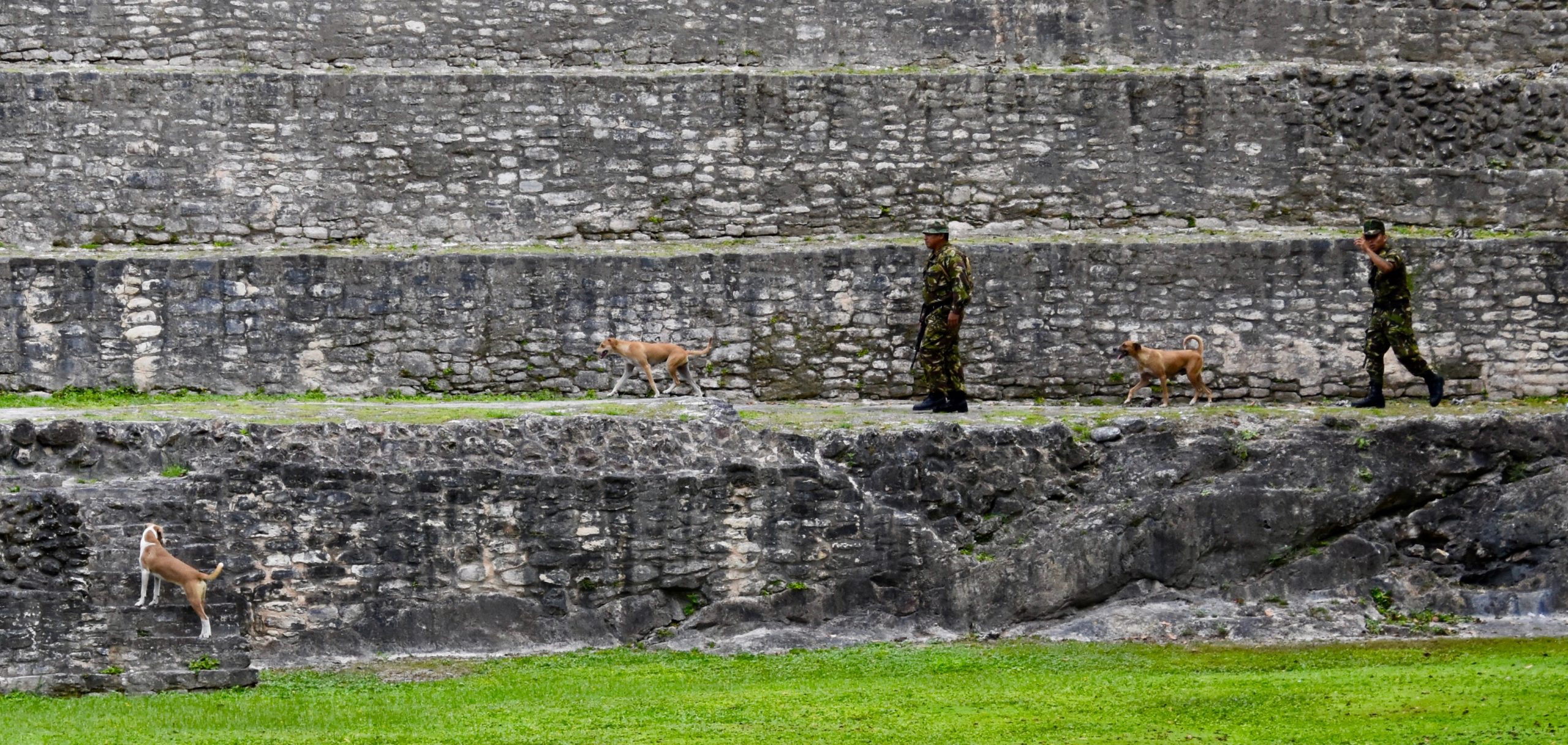
Our guides, whose names I have unfortunately forgotten, were not only knowledgable about the history of Caracol, but the natural world as well. Here they are explaining the importance of the stemadenia Donnel Smithi tree, aka Horse Balls tree which is both a natural insecticide and a cure for worms. Who knew?
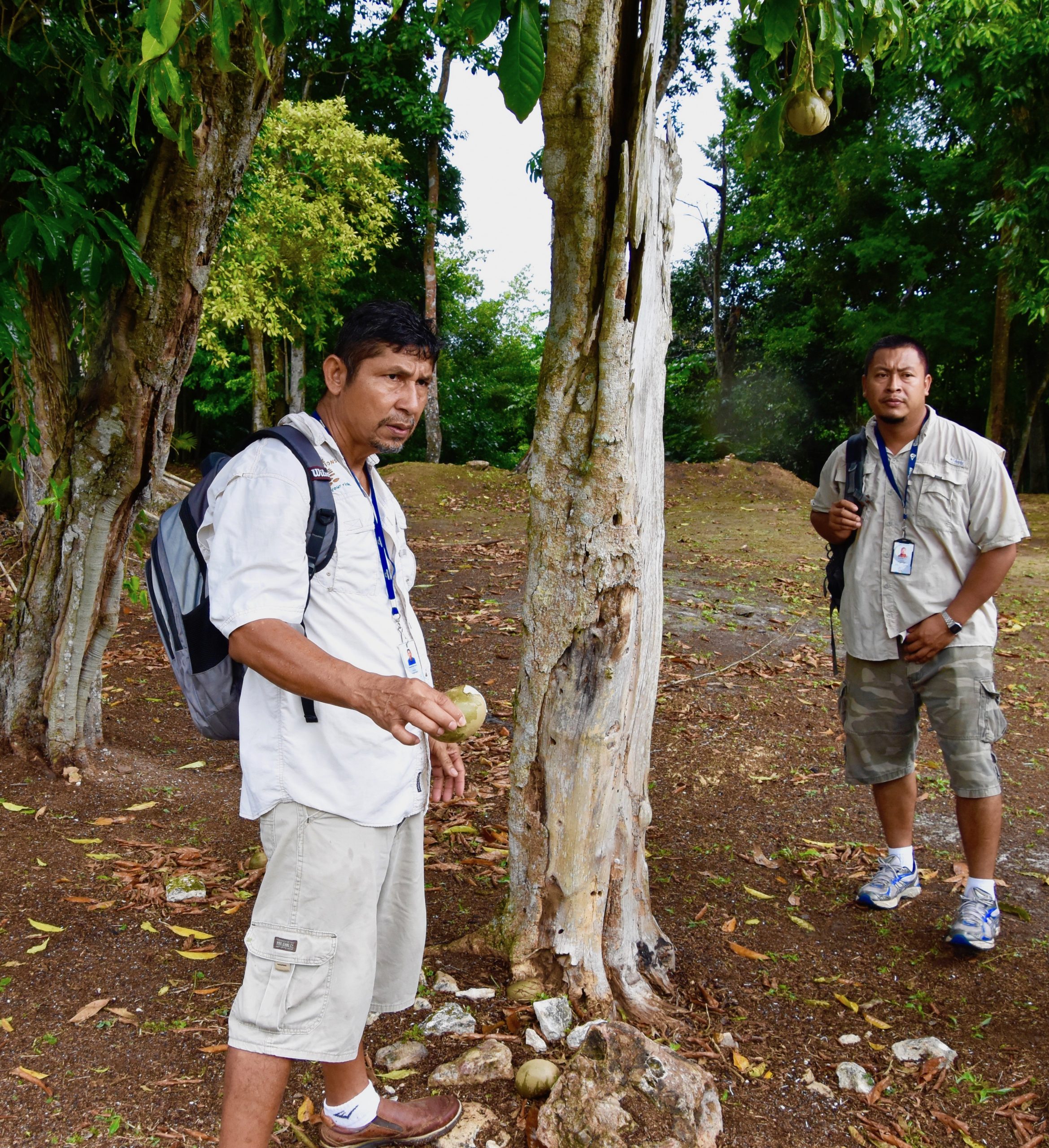
Caracol is not the type of place you want to take your eyes off the ground because there are roots everywhere that can easily twist an ankle or worse.
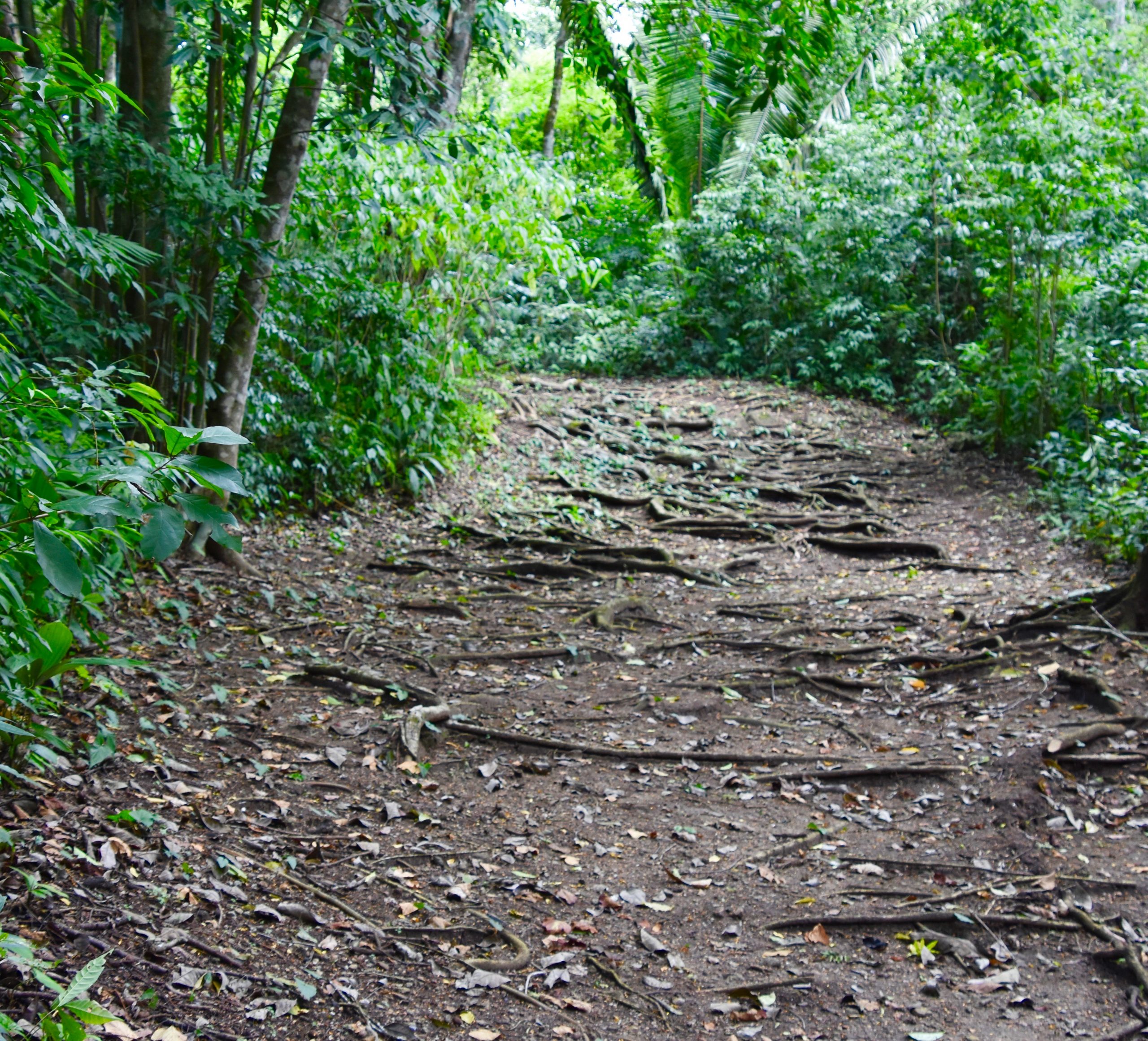
Just like at Tikal there are howler monkeys in the trees overhead. The guides warn us that they love to throw shit at passersby so I don’t know whether it’s wiser to look down for roots or up for flying shit. Instead I stood still for a while and took this video. Listen carefully for the howlers.
Similar to my post on Tikal, I’m going to stick just to the highlights of Caracol starting with this interesting altar which according to the guides depicts the sacrifice of two kings captured in one of the many wars fought between Caracol and its neighbours. From other sources I can confirm that it does represent two bound captives and once you were captured in the Mayan world there was little doubt of what your fate would be.
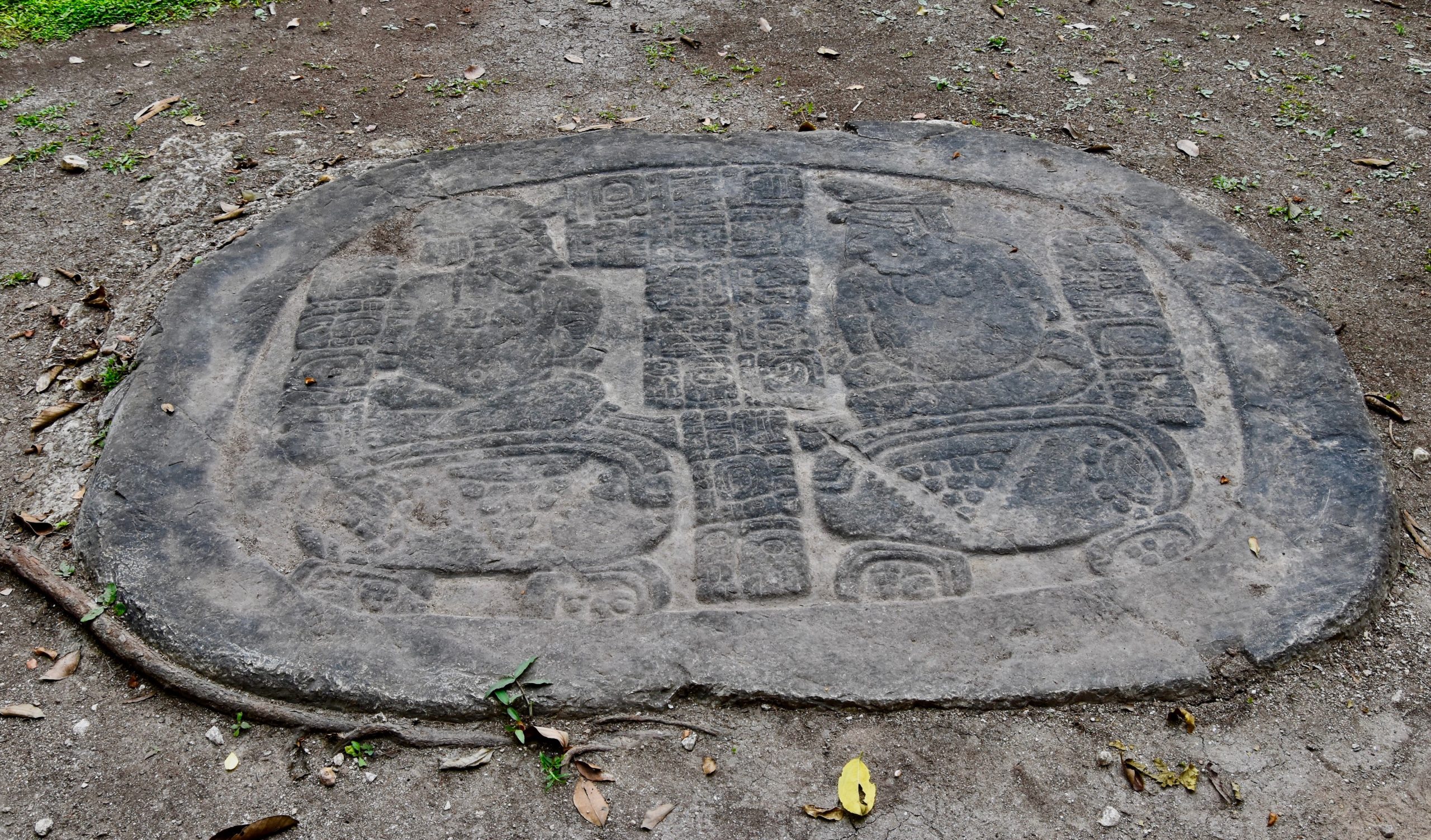
This is as good a time and place to give consideration to the two competing theories about the state of affairs in the Americas before the arrival of the Europeans. On the one hand we have Thomas Hobbes ‘State of Nature’ theory in which he espoused that American Indigenous peoples were living, before being ‘discovered’, in a ‘war of all against all’. His description of their lives as ‘solitary, poor, nasty, brutish and short’ was used as justification for pretty well doing anything the Europeans wanted to them because, well, they’re lives were shit anyway so what the hell. On the other hand we have the Noble Savage theory wrongly attributed to Jean-Jacques Rousseau which posited that the same people Hobbes was referring to were living in some kind of Edenic bliss at harmony with nature and at peace with each other.
Based upon what we have seen from El Salvador to Belize it appears that Hobbes was probably more correct than Rousseau, but not entirely. The Mayans were certainly not solitary, living in cities larger than those in many modern day countries and their lives were not necessarily short, some Mayan rulers living well into their 80’s. In terms of being poor, the palaces and temples they built make it clear that the elites were anything but. However, as for the state of the ordinary Mayan, we really don’t know. If Hobbes got these things wrong, he was certainly right about the nastiness and brutality prevalent throughout the Mayan world where there did seem to be a state of constant warfare between the various city states and no mercy given to the losers. And they definitely were not as one with nature, destroying natural resources and depleting the soil in ways that eventually were significant if not the primary factor in the eventual failure of the entire system.
Looking at it from the 100 mile view and with the benefit of traveling through six continents and seven decades, I can claim, without fear of contradiction based on science and facts, that the Mayans were human beings exactly like the rest of us. No more noble and no more savage than each and every one of us.
With that editorial out of the way let’s visit the Sky Palace. This is the base.
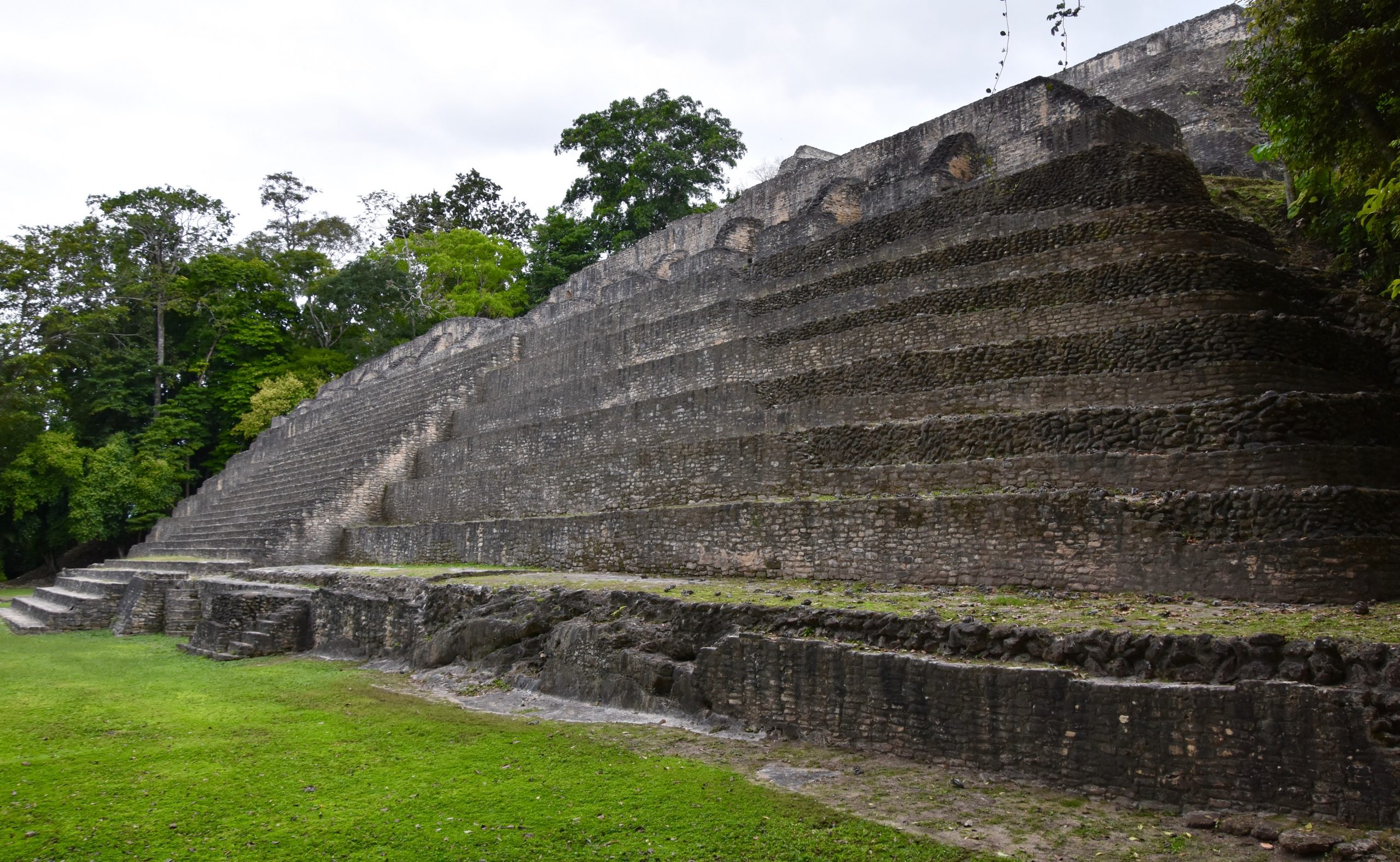
This is the view from the plaza in front. It looks like there are two levels, but there are actually three.
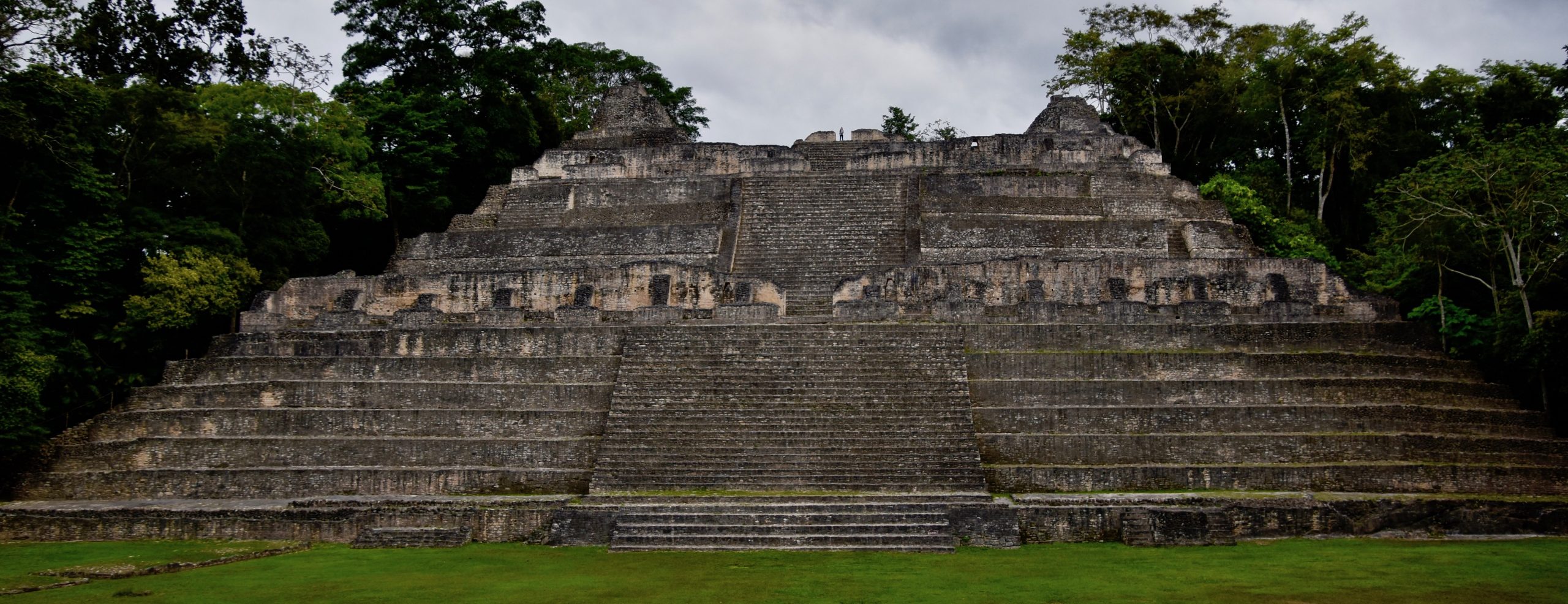
Before we climb it, here is a short video of the main plaza at Caracol.
From afar, it doesn’t look that steep, but up close you realize that the steps are quite steep and they get steeper from one level to the next. It’s not the going up that’s an issue, it’s the going down.
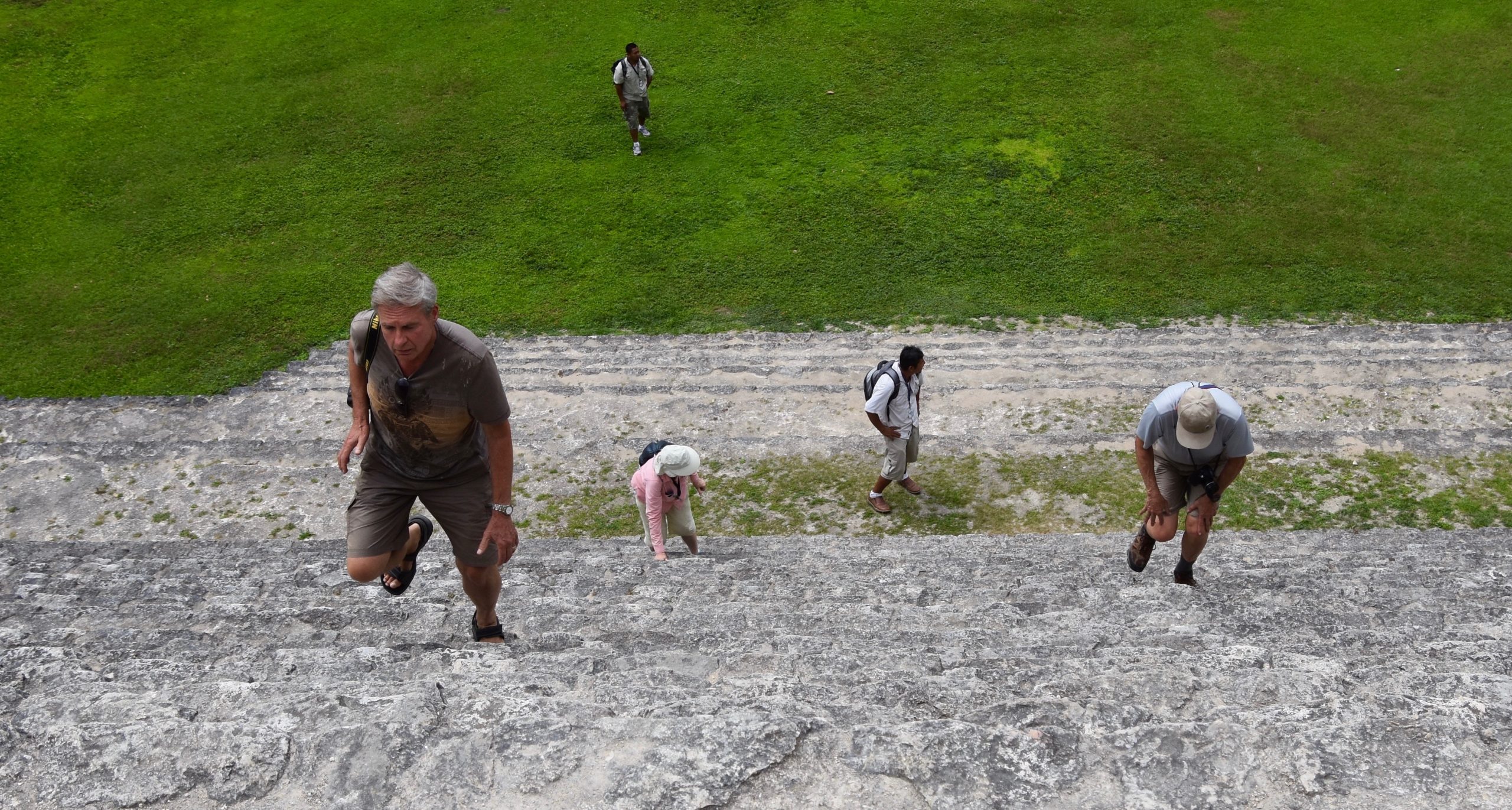
This is the view from the top of the second level.
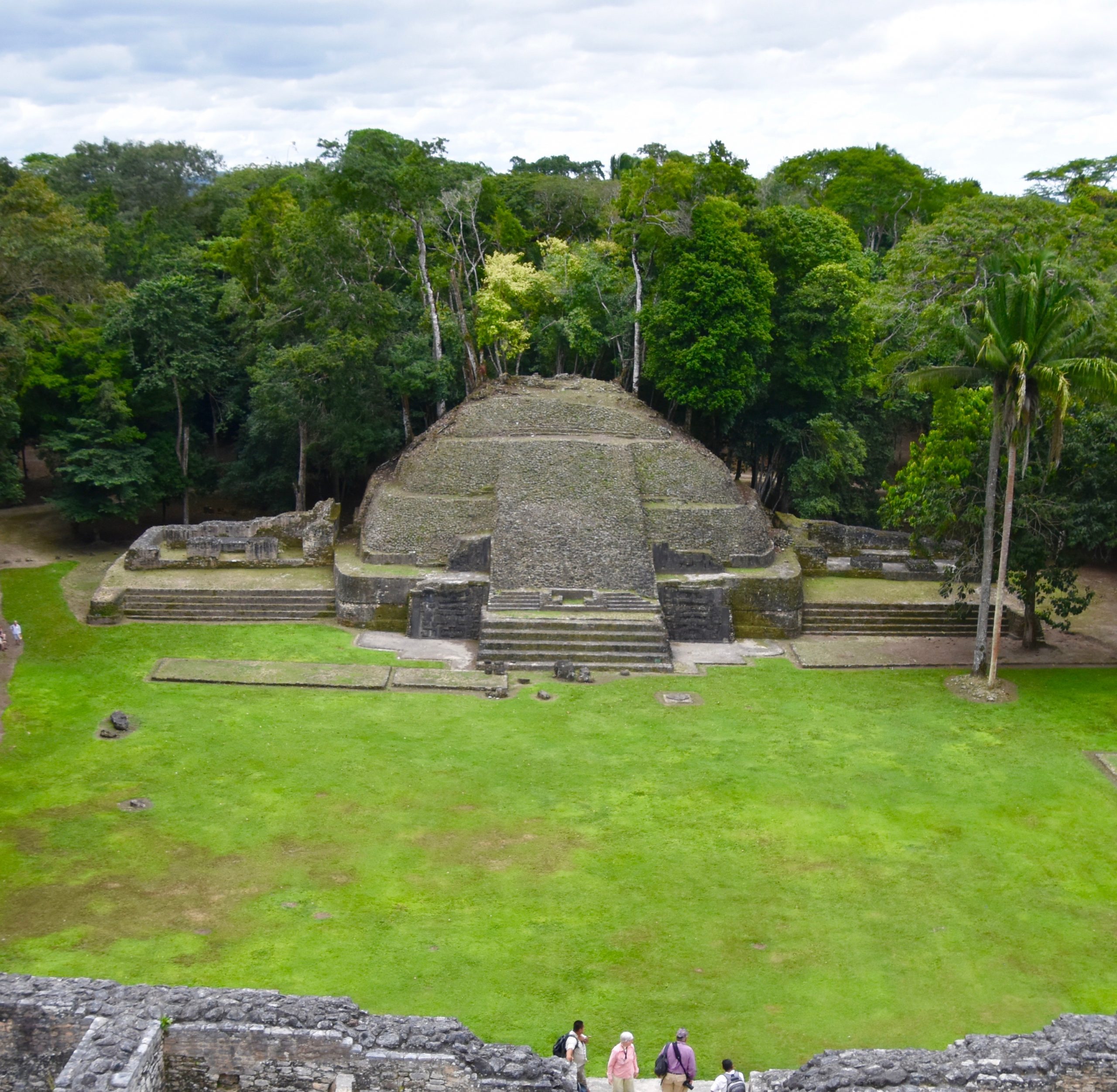
And the view from the very top, the highest man made point in all of Belize. The Empire State building held the title of world’s tallest for 36 years and the CN Tower for 25, but this place has been its country’s record holder for over 1,200 years and there’s still no contender in sight.
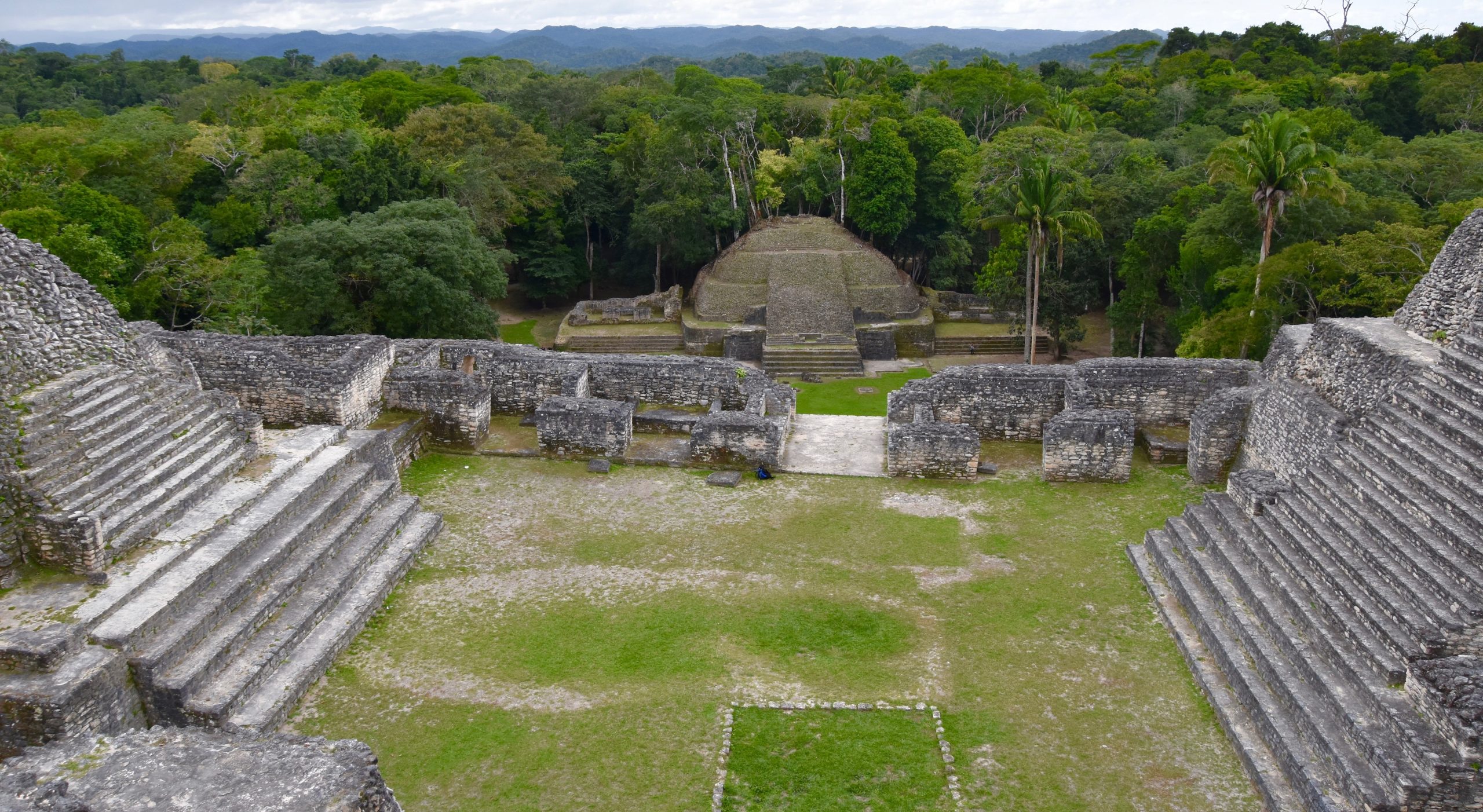
And courtesy of Brian Palardy, proof that I did make it to the top.
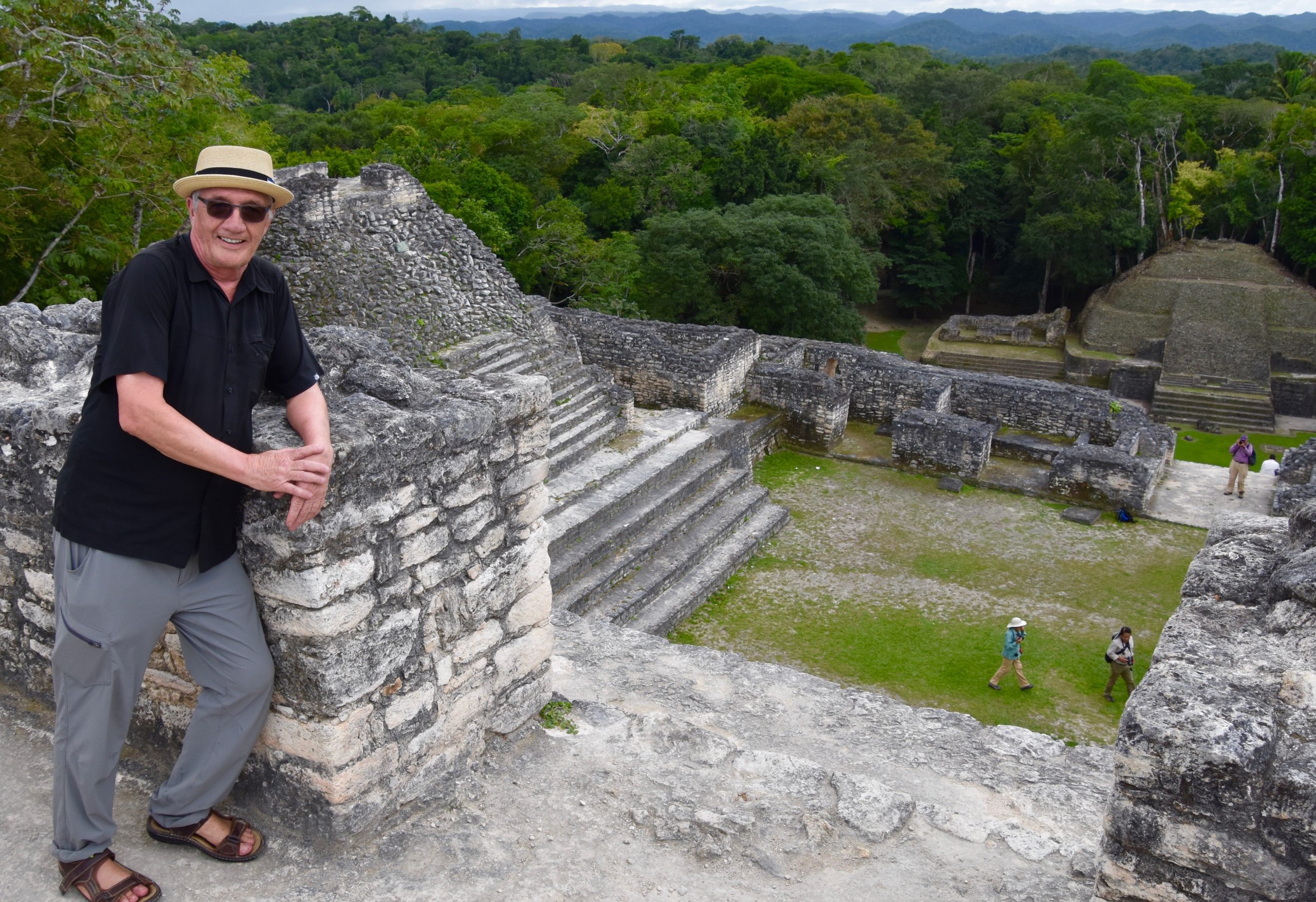
As I said, it’s the going down that’s a little more tricky because one slip and you are toast.

At the bottom I don’t know if I was more relieved or sad that this would be the final pyramid I would be climbing on this trip and maybe in my lifetime.
The wildlife sightings also continued with this friendly tarantula which the guides enticed out of its hole with a little twig. Contrary to what most believe tarantula bites are not that common or that serious. Their venom is weak and more like a bee sting than a deadly snake bite which is why some people keep them as pets.
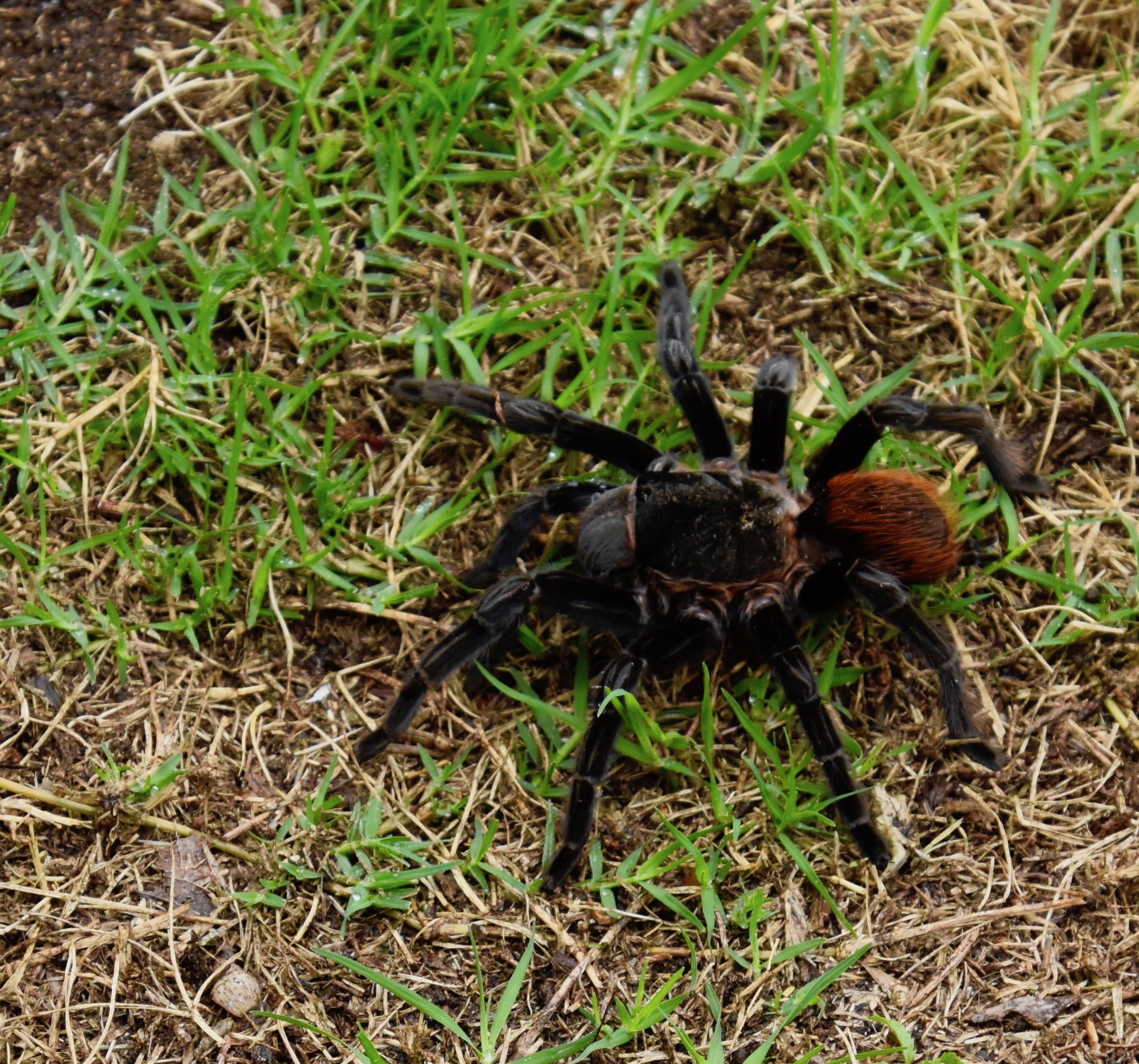
Leaving the tarantula be, our group made it back to the main entrance where there were a few covered picnic tables and we had a late lunch, but alas, no beer.

I wasn’t exactly thrilled about the prospect of the three hour drive back to Black Rock lodge, but it was made interesting by a stop at the pools on the Rio On where the guides invited us in for a swim.
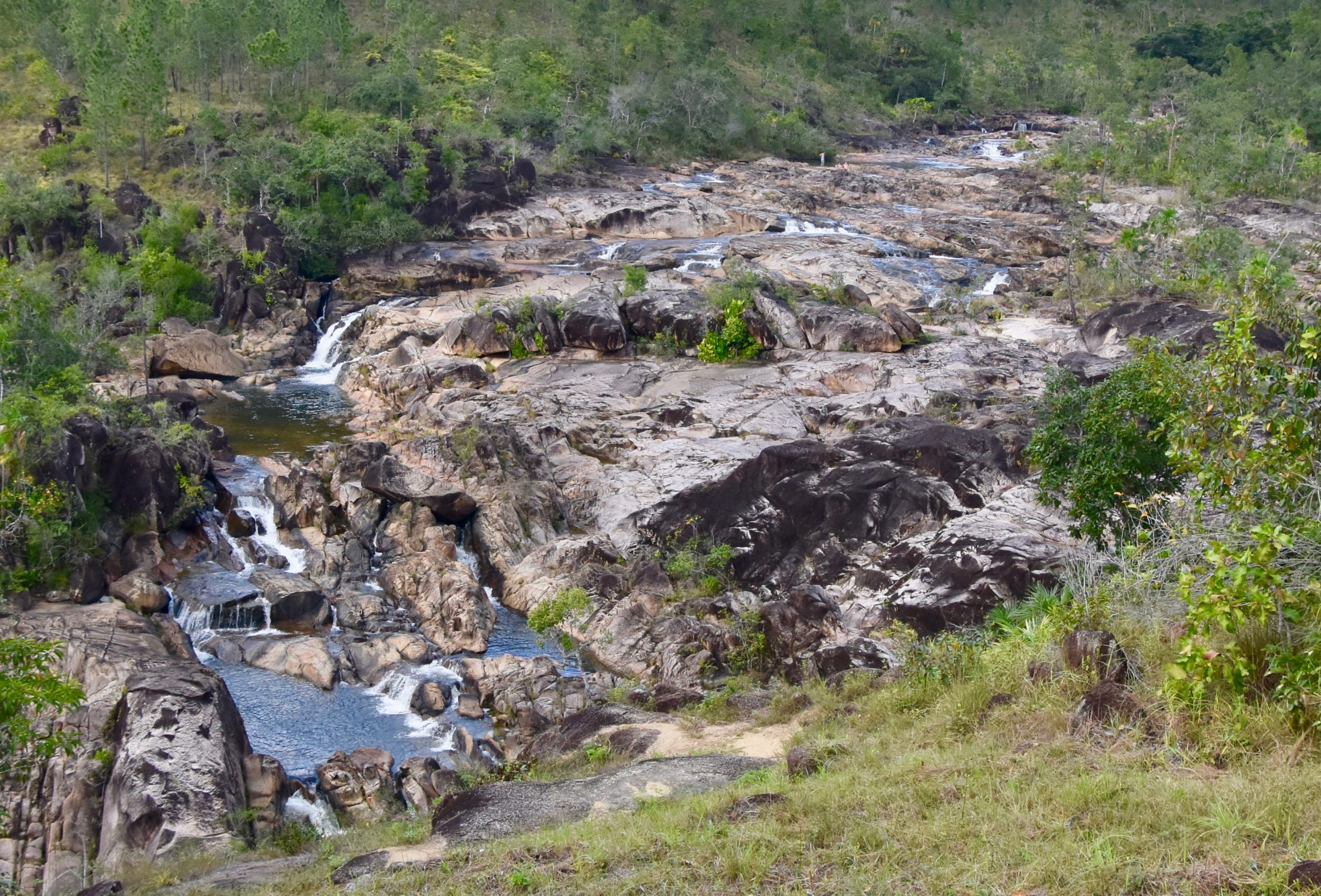
We all declined the offer, but there were others refreshing themselves in what, if I were forty years younger, would have been a no-brainer.
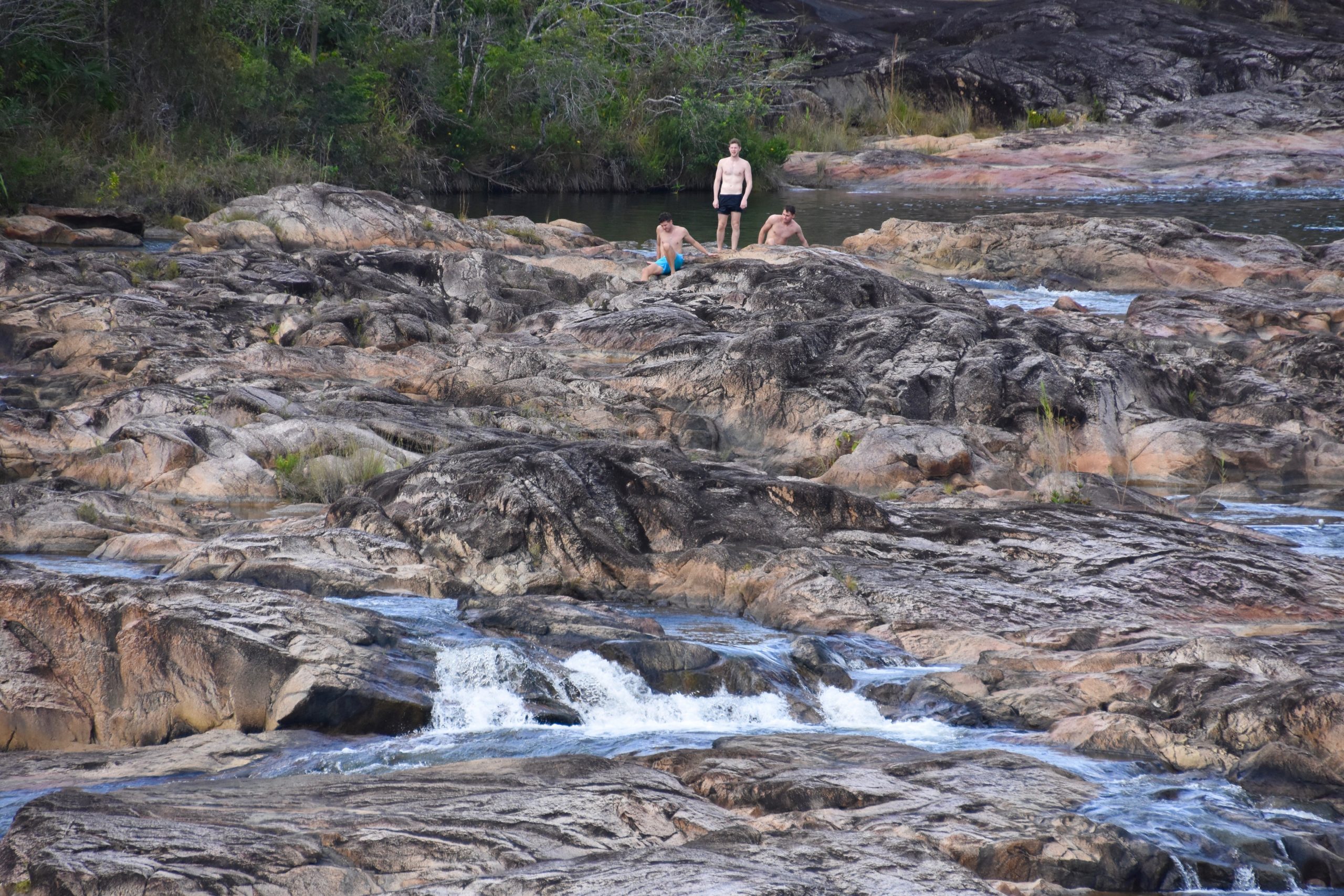
Surprisingly, the rest of the trip back seemed to go by almost in a flash or maybe I was just light headed. I can tell you that visions of a cold Belikin at the bar were dancing in my head.
Back at Black Rock Alison shared pictures of a few of the birds and flowers she had photographed during her excursions and we both agreed that we had picked our best options for the day.
Tomorrow is a day I always dread – the last on a tour I hoped would never end. Hope you’ll check in to see how it goes as we part ways with Victor and a group that has begun to seem like family.

